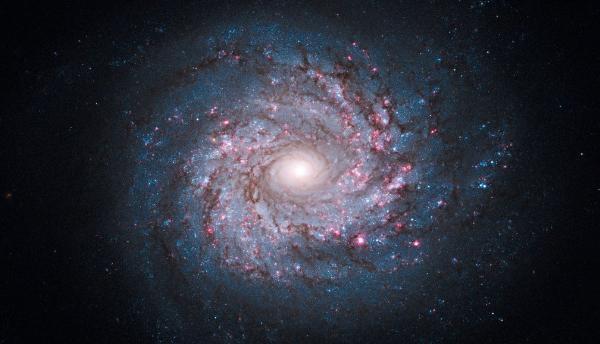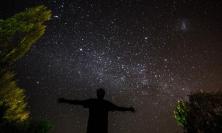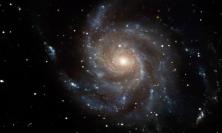In the second of his series of articles for Thinking Faith, Vatican astronomer, Guy Consolmagno SJ, traces how our understanding of the Universe has developed over the centuries, and the place of God both in this Universe and in this understanding.
In the opening words of the Creed we claim to believe in a God who created heaven and earth. That idea comes directly to us from Genesis, which also tells us that at each stage of creation, the Creator looked at this creation and said it was Good.
In the Psalms, we’re told “the heavens proclaim the greatness of God.” In Baruch, we’re told how at their creation “the stars shone in their watches, and were glad; he called them, and they said, ‘Here we are!’ and shone with gladness for Him who made them.” And in Paul’s Letter to the Romans we’re told that “since the creation of the world God’s invisible attributes, His eternal power and divine nature, have been clearly seen, being understood through what has been made.”
And so it is very natural that those who believe in Genesis – the Jews and the Christians and the Muslims – should also support science as a way of getting to know God. That’s the irony of the so-called war between science and religion: science itself is actually borne out of religion.
After all, where is most science done? At universities. And who founded those universities? The church. Indeed, until the middle of the 19th century and the rise of the state universities, many scientists were in fact clergymen. Who else had the education and the free time to go out collecting and classifying leaves and bugs and all the other day-to-day, data-gathering things that form the backbone of science? And what do we call the work of sorting and filing information? Clerical work. Work done by clerics.
But the religious roots of science are even deeper than who pays the bills. We all know that any logical system must start with fundamental, unprovable assumptions... and there are at least three axioms of science that must be taken on faith before you can do science.
You have to believe that the physical world actually exists – I am not just a butterfly, dreaming that I am a scientist, in an imaginary universe.
You have to believe, ahead of time, that the physical world actually does have rules and regularities – well hidden ones perhaps, but something that eventually you’ll be able to figure out. And when you consider how complicated things are in this universe, and how many centuries it has taken us to get as far as we’ve gotten, you have to appreciate what a huge assumption this was for those at the foundations of science, the monks back in the middle ages like Albert the Great and Roger Bacon who first thought of organizing our understanding of the physical universe.
But third, and most profoundly, you have to believe that the physical universe is worth studying. Think of it... if your religion says that the goal of life is to meditate yourself out of this corrupting universe onto a higher plane, you’re not going to be a physical scientist. Only a culture based on a religion that insists that the physical universe was deliberately made by a Creator God, who looked at it and said it was good, is going to support anyone who wants to spend their life (and the culture’s resources) studying that physical universe. Only such a religion could possibly believe that you could find God in the book of nature.
And so, this means that as astronomy expands our understanding of what is in creation and how it operates, it inevitably colours the ways we understand who that God is and how that God operates.
A particularly significant challenge that astronomy gives to this creed is the way it redefines the meaning of “heaven and earth.” My own branch of astronomy, planetary science, has provided ever new visions of what “heaven and earth” actually means.
When the writers of the creed talked about God creating the “earth” they were thinking of the physical universe in general. They assumed that the physical universe was equivalent to, and no more than, the earth they saw all around them. You look around and can see for yourself what the universe looks like. There is this flat disk of dirt and streams and lakes we call “here,” the earth; and a sky overhead that makes a dome over this disk, that we call the “heavens.” (Remember, in Romance languages, the word for sky is the same as the word for heaven.)
And that’s where the first picture of the universe started from. It’s based on observational evidence; good science, as far as it went. It formed the basis of all ancient cosmologies; and so the first chapter of Genesis describes God creating such a sky, “a dome in the midst of the waters” that separates the “waters” above and below the land on which plants, animals, and people are eventually placed.
You can develop this picture – many ancient cultures did – by postulating all sorts of different heavens, layers of heaven, that line up with your understanding of the spiritual realm. For example, last spring when I was speaking to a group of native American Indian elders in northern Wisconsin about meteorites, rocks that fall out of the sky, they wanted to know: which sky?
You can see some stars in the night-time sky that move among the other, fixed stars; these wandering stars are called planets.And if you plot their positions night after night, you can see them move; eventually you see that sometimes they move backwards. There are seven visible planets (if you include the sun and the moon); hence, seven levels of heaven that anyone can see for themselves.
The Pythagorean mathematician Eudoxus, about 350 BC, explained the observed motions of the planets by describing the universe as an elaborate system of interlocking transparent spheres whose axes of rotation pass through the Earth. By then, the Earth itself was long recognized as a sphere: probably the Pythagoreans had worked that out a hundred and fifty years earlier. Aristotle (we’re up to about 330 BC now) referred to the Eudoxus system in his geocentric cosmology. His physics was based on the idea that elements move so as to achieve their natural resting places, up or down, fire and air, water and earth… natural places that corresponded to “spheres of heaven” again. And Aristotle’s work was the basis of most philosophical thought for the next 1500 years.
The Roman astronomer Ptolemy in the second century AD used the planetary observations by the Babylonians and Greeks to flesh out Aristotle’s geocentric cosmology with mathematical rigour. He provided mathematical tools that worked, when it came to predicting the positions of the planets, including their backwards motion. Because they worked, for the next millennium philosophers accepted his cosmological premises as true. (The idea that if a system works for a particular case, then it must be true in general, is a common logical fallacy that continually plagues science.)
The Ptolemaic system was a far cry from the water-covered dome described in Genesis. Saint Augustine noted this; writing On the Literal Interpretation of Genesis in the early 5th century he warned that “even a non- Christian knows something about the earth, the heavens, and the other elements of this world, about the motion and orbit of the stars and even their size and relative positions, about the predictable eclipses of the sun and moon, the cycles of the years and the seasons... and this knowledge he holds to as being certain from reason and experience. Now, it is a disgraceful and dangerous thing for a non-believer to hear a Christian, presumably giving the meaning of Holy Scripture, talking nonsense on these topics.”
Of course, the understanding of the universe that “everyone knows” is true was, in fact, the Ptolemaic model.
But this difference did not lead to a fifth-century crisis comparable to the Galileo affair. Instead, most theologians continued to see in this physical cosmology a reflection of the non-physical universe. They assumed that the physical universe mirrors the spiritual realm, describing a “chain of creation” where the orbital “spheres” of the observed planets were moved by the angels in the space between Earth and the Firmament, the final sphere of the universe, beyond which the saints themselves could be found. Beyond that, the perfect eternal circular motions of the planets were placed in contrast to the irregular and finite movements of objects on Earth. Earth itself stood not at the centre of the universe, but at the bottom of the chain of creation, only one level removed from the levels of the Inferno.
And notice, the study of the motions of the planets was considered a part of natural philosophy; the study of cosmology was considered a branch of theology. So when theologians like Thomas Aquinas successfully reconciled Aristotle’s physics with Christian theology, by the time of the Renaissance many people saw any challenge to Aristotle as a challenge to the principles of Christian theology itself. This helped give rise to the well-known problems between the church and the heliocentric viewpoint espoused most famously by Galileo.
But even the man who finally made the heliocentric model work, Johannes Kepler, adopted a personal cosmology that, like the medieval “Chain of Creation,” drew connections between the physical and supernatural worlds.
Recall that the original Copernican system of circular orbits still required some small epicyclic motion of the sun about an average center point in order to match its observed position against the background stars, assuming the Earth and the planets moved in perfect circles. Seeing a parallel between light emitted from the sun falling on the Earth, and the Holy Spirit radiating from the Father onto the Son, Kepler argued against that epicyclic motion, and replaced those circles and epicycles with elliptical planetary orbits. This allowed the sun to remain stationary at the centre of the universe – as he argued, would only be fitting for the physical analogue of God the Father.
The new physics of Isaac Newton fifty years later provided a viable replacement for Aristotle’s system. It successfully reproduced Kepler’s elliptical orbits by using physical laws that acted the same both on celestial bodies and on objects as humble as an apple falling from a tree. The Earth and everything on it was no longer at the bottom of a chain of creation, but raised to a status equal to that of the other planets. Newton’s physics showed that “Earth” was not in a unique place in the universe, favoured or disfavoured in contrast to the heavens. It completed what had started with the heliocentric revolution: the death of the concept that the physical universe could be thought of as a parallel to the spiritual universe.
The Jesuits played a role in this shift, as described in a recent book by Marcus Hellyer called Catholic Physics. After the Galileo affair, for the next hundred years it was forbidden for the Copernican system to be taught as a true cosmology… in the natural philosophy classroom. But but everyone agreed it was a useful calculating tool. So Copernicus, Kepler, and Newton were taught by Jesuits in the mathematics classroom. Astronomy stopped being a branch of philosophy, and became a branch of mathematics.
And this, in turn, freed up science to look more carefully at the concept of “other worlds.” The medievals had understood how thoughts of other worlds would shatter the sense that the physical world paralleled spiritual reality. If there were other worlds, would that mean there were other layers of other kinds of angels around each star? But they knew that to deny the possibility of other worlds denied the omnipotence of God.
The reality of other worlds has been understood, intellectually, since the enlightenment; indeed, we’ve had stories speculating about life on other planets since Roman times. In the 1920’s, the development of the aeroplane and the radio made it feel reasonable that one could possibly travel to such places; this laid the groundwork for the new genre of science fiction, which mass-marketed this idea, albeit an idea still labelled as Amazing or Astounding. But it was only when we’ve actually been able to see the real planets in our solar system, close up, that this reality has come home to us at a gut, emotional level.
Meanwhile, about a year ago, a team lead by Stéphane Udry of the Geneva Observatory announced the discovery of three planets around the red dwarf star, Gliese 581, a star only twenty light years away from us. Apparently one of these planets is only about eight times the mass of Earth and about 50% bigger in radius. Orbiting close to its sun, its year is less than two weeks long; but because that star is so small and dim compared to ours, even at that close distance the temperatures on this planet will only range between zero and 40 Celsius… Room temperature. Water should be liquid there, perhaps covering its surface with oceans ripe for life.
Space telescopes optimized to search for planets, especially terrestrial planets, are being designed; the first are being built; a French prototype called COROT has already been launched, and found its first planets. They’ll study dense fields of stars like the Milky Way that is found in the constellation Cygnus. Instead of the two hundred or so planetary systems that have been discovered so far, ten years from now we may know tens of thousands of systems that have planets… including, I repeat, Earth-sized terrestrial planets. This is “many worlds” with a vengeance.
All these planets pose the ever increasing possibility of extraterrestrial intelligence. Indeed, for the last twenty years there’s been an intense (if so far unsuccessful) search for life outside of Earth. How does this challenge the assumptions underlying the traditional explanations of original sin and Christ's salvation?
This question has been debated for centuries. Two hundred years ago, the astronomer John Herschel saw life on other planets as the inevitable result of God’s fecundity, while Thomas Paine mocked the idea of a Saviour who had to suffer and die, over and over again, on countless worlds.
If there are other planets suitable for life, if there is life on those planets, if that life is intelligent, if that life is in a free, self-aware, loving relationship with the Creator, if that life can communicate to us about their experience of that relationship...well, that’s a lot of “ifs.” If it’s so, then certainly we could have a lot to talk to each other about. But if any of that chain of “ifs” turns out wrong, we’ll never know. Yet even if it is never known, the very possibility of other planets raises those questions.
New worlds, new planets, new ideas for the way the universe is put together, continue to challenge the traditional ways we understand God and how He works in the universe. But my point here is not to come up with “answers” to all of these challenges. As the philosophers point out, there is a difference between a “problem” and a “mystery.” The scientific “problems” are questions that can be definitively answered, allowing us to move on to the next “problem” -- is there a planet around this star, yes or no? Can we see life on that planet? But mysteries are questions that we come back and revisit, over and over, as our understanding grows. Why did God create the universe? Why is there evil? What is the meaning of Jesus’s salvation? These are questions we will never exhaust.
As we solve each scientific problem, we have new knowledge to add to our understanding of the mysteries. As we dig deeper into each mystery, we can be inspired to new questions, some of which may be amenable to scientific analysis. And each step bringing us closer to the Truth, brings us closer to the Creator of Truth.
Guy Consolmagno SJ is an American Jesuit working at the Vatican Observatory in Castel Gandolfo, Italy, where he conducts research on asteroids and comets, and serves as curator of the Vatican’s collection of meteorites. He is the author of several popular books on astronomy and religion.
This series of articles is adapted from talks given at the Jesuit Living Theology seminar held at Ushaw College from 25 - 29 March 2008. Included in these texts are extended quotations from the author's previously published material, notably from God’s Mechanics: How Scientists and Engineers Make Sense of Religion (Jossey-Bass, 2008); copyright and all rights reserved.
![]() The Vatican Observatory
The Vatican Observatory
![]() God's Mechanics: How Scientists and Engineers
God's Mechanics: How Scientists and Engineers
Make Sense of Religion by Guy Consolmagno SJ






